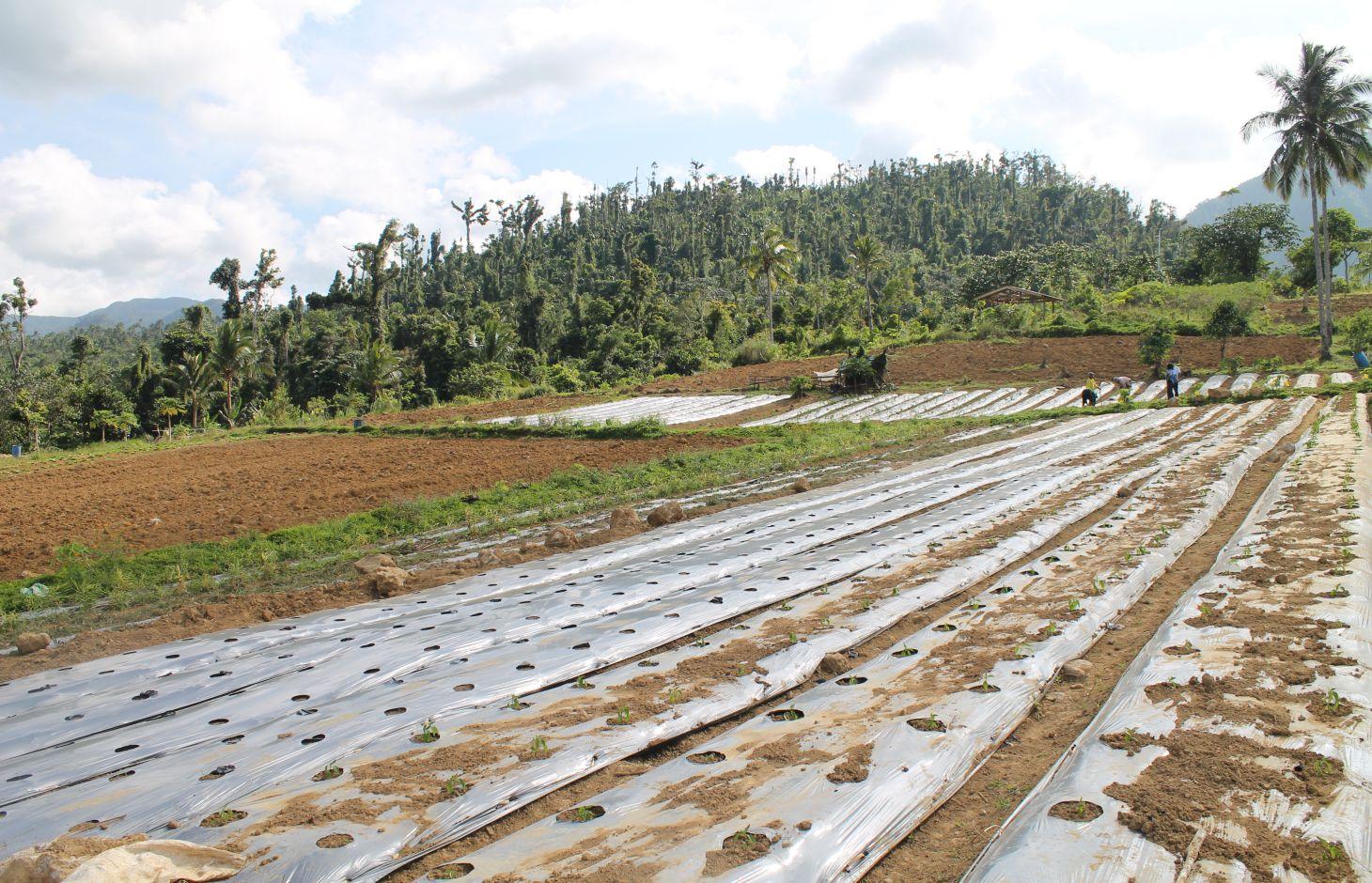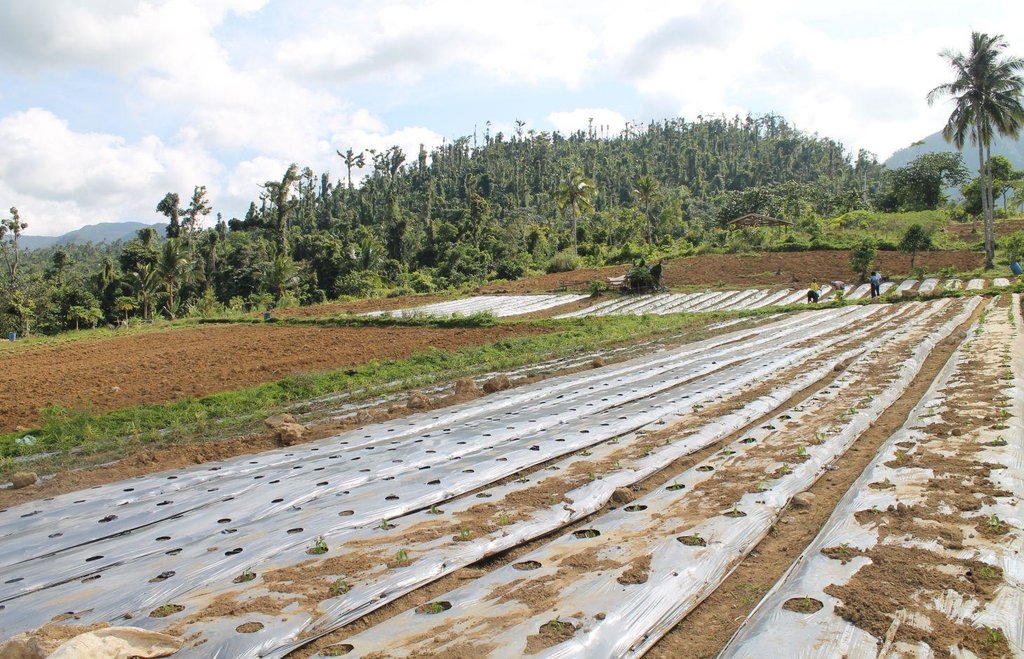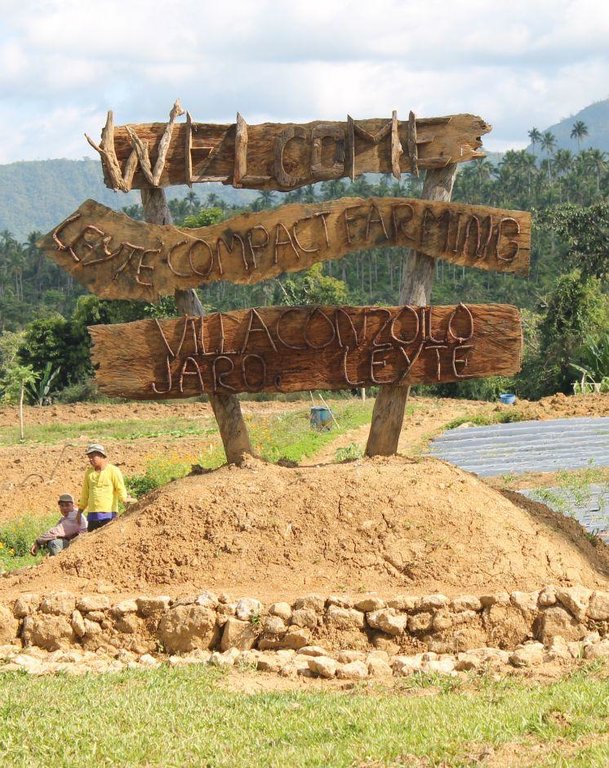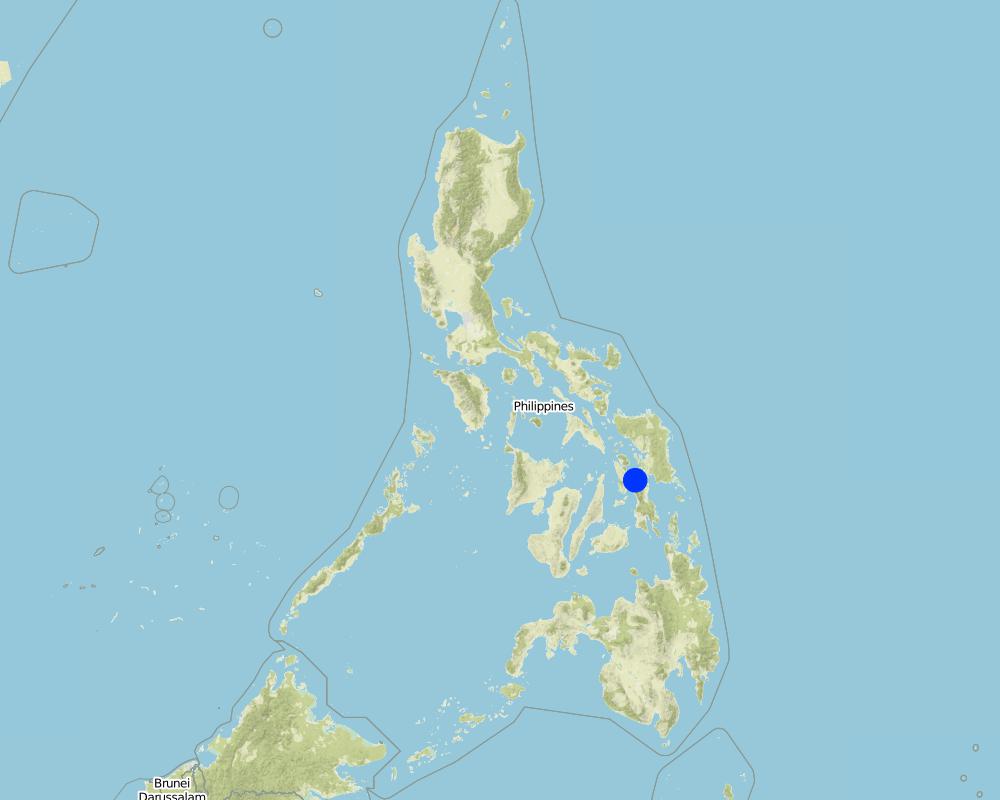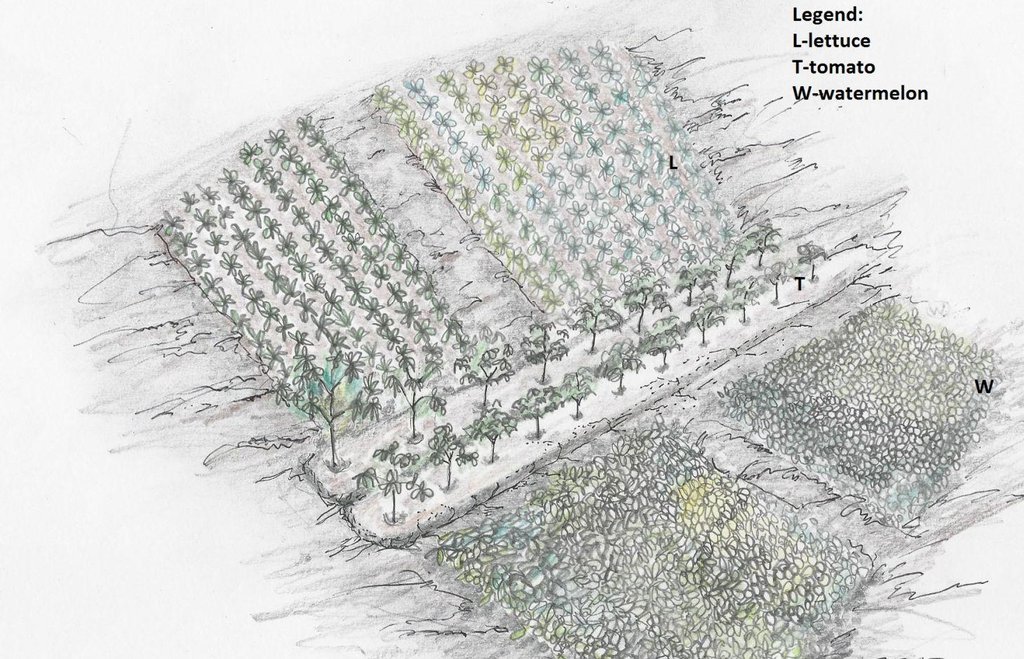Compact Farming for Vegetables Production [菲律宾]
- 创建:
- 更新:
- 编制者: Philippine Overview of Conservation Approaches and Technologies
- 编辑者: –
- 审查者: Fabian Ottiger, Alexandra Gavilano
technologies_1300 - 菲律宾
查看章节
全部展开 全部收起1. 一般信息
1.2 参与该技术评估和文件编制的资源人员和机构的联系方式
关键资源人
SLM专业人员:
Dinamling Djolly Ma
Department of Agriculture-Bureau of Soils and Water Management
菲律宾
SLM专业人员:
Raquid Jemar G.
Department of Agriculture-Bureau of Soils and Water Management
菲律宾
SLM专业人员:
Rapis Thelma
Department of Agriculture-Region VIII
菲律宾
SLM专业人员:
Garcia Pastor
Visayas State University, Baybay, Leyte
菲律宾
有助于对技术进行记录/评估的机构名称(如相关)
Bureau of Soils and Water Management (Bureau of Soils and Water Management) - 菲律宾有助于对技术进行记录/评估的机构名称(如相关)
Visayas State University (VSU) - 菲律宾1.3 关于使用通过WOCAT记录的数据的条件
编制者和关键资源人员接受有关使用通过WOCAT记录数据的条件。:
是
2. SLM技术的说明
2.1 技术简介
技术定义:
Landusers are organized into a group or association to undertake jointly activities in the farm which include operation, input procurement, and marketing of produced crops.
2.2 技术的详细说明
说明:
Compact farming in Brgy. Villaconzoilo was started by the barangay captain Mr. Alex O. Aborita wherein parcels of lands were acquired for the association to utilize. He organized the Villaconzoilo farmers’ group also known as the Compact Farming Agriculture Cooperative where he introduced new technologies to improve the farming system of the community. Farmers cultivate vegetable on a contract growing scheme. Some of the farm practices consist of growing vegetables and fruits using indigenous organic materials as soil conditioner and livestock raising. Vegetables and fruits are cultivated in divided parts but in the same area.
Purpose of the Technology: Compact farming was organized to enhance group interactions and leadership among members of the association.The aim of the landusers in growing organic vegetables is to revive and sustain soil fertility and maximize waste management practice. Marigold was also planted in between plots within the farm to prevent and control insect and pest manifestation. Landusers in the barangay were empowered through farming and conservation of the forest area. Through this technology, marketability and available markets for the produced commodities were increased. The association received numerous award in the regional and provincial level because of their demonstration of a productive and profitable farming system in the upland area.
Establishment / maintenance activities and inputs: It started in 2011 with 18 farmers investing 1000 pesos (22 dollars) each to buy initial inputs such as land, seeds and fertilizer. The area was cleared for agricultural activities. Produced are high value crops such as tomatoes, lettuce, pechay, cabbage, carrots, beans, broccoli, cucumber, and radish. These are sold not only in Jaro but also in the neighbouring municipalities and big markets in Leyte. The barangay was dubbed as the “Vegetable Basket” and the “Watermelon Queen” because of their production. Activities in the farm such as plowing, harrowing, establishment of plots, fertilizer application, transplanting, watering, spraying and harvesting are done in a rotational basis among members of the association.
Natural / human environment: Most of the farmers cultivated one parcel with size ranging from 1000-2000 square meters. Land ownership and land use right is communal. The farm production is managed by the cooperative composed of small scale land users. Members of the association are enganged in off-farm activities such as hunting and hired labor for additional income. The municipality of Jaro, Leyte has a type A modified climatic classification with an average monthly rainfall of 1000 to 1500 mm. Typhoons that usually come in October or November is very destructive to any standing crop. These factors discourage farmers to apply external inputs like fertilizer. The municipality has mostly acidic soil type with pH ranging 4.8 to 5.6.
2.3 技术照片
2.5 已应用该技术的、本评估所涵盖的国家/地区/地点
国家:
菲律宾
区域/州/省:
Barangay Villaconzoilo
有关地点的进一步说明:
Jaro, Leyte
注释:
Total area covered by the SLM Technology is 0.08
Map
×2.6 实施日期
如果不知道确切的年份,请说明大概的日期:
- 不到10年前(最近)
2.7 技术介绍
详细说明该技术是如何引入的:
- 通过土地使用者的创新
3. SLM技术的分类
3.2 应用该技术的当前土地利用类型

农田
- 一年一作
年作 - 具体指明作物:
- 蔬菜 - 叶菜(色拉、卷心菜、菠菜和其他)
- 蔬菜 - 香瓜、南瓜、南瓜或葫芦
- 蔬菜 - 根茎类蔬菜(胡萝卜、洋葱、甜菜等)
- tomatoes
具体说明:
Longest growing period from month to month: growing of vegetables throughout the yr.
注释:
Major cash crop: tomato, carrot, watermelon, lettuce, broccoli
Major land use problems (compiler’s opinion): low soil fertility, nutrient imbalance
Future (final) land use (after implementation of SLM Technology): Cropland: Ca: Annual cropping
3.3 由于技术的实施,土地使用是否发生了变化?
由于技术的实施,土地使用是否发生了变化?:
- 是(请在技术实施前填写以下有关土地利用的问题)
同一土地单元内混合使用的土地::
是
具体说明混合土地使用(作物/放牧/树木):
- 农林业

农田

森林/林地
3.4 供水
注释:
Water supply: mixed rainfed - irrigated, mixed rainfed - irrigated
3.5 该技术所属的SLM组
- 废物管理/废水管理
- Sustain soil fertility
3.6 包含该技术的可持续土地管理措施

农艺措施
- A1:植被和土壤覆盖层
- A2:有机质/土壤肥力
注释:
Main measures: agronomic measures
Type of agronomic measures: temporary trashlines, soil conditioners (lime, gypsum), rotations / fallows
3.7 该技术强调的主要土地退化类型

化学性土壤退化
- Cn:肥力下降和有机质含量下降(非侵蚀所致)
- Ca:酸化

生物性退化
- Bc:植被覆盖的减少
- Bl:土壤寿命损失
注释:
Main type of degradation addressed: Cn: fertility decline and reduced organic matter content, Ca: acidification
Secondary types of degradation addressed: Bc: reduction of vegetation cover, Bl: loss of soil life
Main causes of degradation: soil management (improper fertilizer application), crop management (annual, perennial, tree/shrub) (disposal/utilization of weeds and crops of weeds residue)
Secondary causes of degradation: Heavy / extreme rainfall (intensity/amounts)
3.8 防止、减少或恢复土地退化
具体数量名该技术与土地退化有关的目标:
- 减少土地退化
注释:
Main goals: mitigation / reduction of land degradation
4. 技术规范、实施活动、投入和成本
4.1 该技术的技术图纸
技术规范(与技术图纸相关):
Tomato, watermelon and lettuce planted in the compact farm of the association.
Technical knowledge required for field staff / advisors: high
Technical knowledge required for land users: high
Main technical functions: increase in organic matter
Secondary technical functions: increase in nutrient availability (supply, recycling,…)
Temporary trashlines
Material/ species: "mani-manihan", marigold
Soil conditioners (lime, gypsum)
Material/ species: chicken dung
作者:
Mr. Patricio A. Yambot, Department of Agriculture-Bureau of Soils and Water Management
4.2 有关投入和成本计算的一般信息
其它/国家货币(具体说明):
pesos
如相关,注明美元与当地货币的汇率(例如1美元=79.9巴西雷亚尔):1美元=:
45.0
注明雇用劳工的每日平均工资成本:
300.00
4.3 技术建立活动
| 活动 | 时间(季度) | |
|---|---|---|
| 1. | Clearing of the area |
4.4 技术建立所需要的费用和投入
| 对投入进行具体说明 | 单位 | 数量 | 单位成本 | 每项投入的总成本 | 土地使用者承担的成本% | |
|---|---|---|---|---|---|---|
| 劳动力 | Clearing of the area | ha | 1.0 | 222.22 | 222.22 | 100.0 |
| 技术建立所需总成本 | 222.22 | |||||
| 技术建立总成本,美元 | 4.94 | |||||
4.5 维护/经常性活动
| 活动 | 时间/频率 | |
|---|---|---|
| 1. | Plowing | |
| 2. | Harrowing | |
| 3. | Establishment of Plots | |
| 4. | Organic Fertilizer Application | |
| 5. | Transplanting | |
| 6. | Watering | |
| 7. | Spraying of botanical pesticide | |
| 8. | Harvesting |
4.6 维护/经常性活动所需要的费用和投入(每年)
| 对投入进行具体说明 | 单位 | 数量 | 单位成本 | 每项投入的总成本 | 土地使用者承担的成本% | |
|---|---|---|---|---|---|---|
| 植物材料 | Seedlings | ha | 1.0 | 111.11 | 111.11 | 100.0 |
| 肥料和杀菌剂 | Fertilizer | ha | 1.0 | 55.56 | 55.56 | 100.0 |
| 技术维护所需总成本 | 166.67 | |||||
| 技术维护总成本,美元 | 3.7 | |||||
5. 自然和人文环境
5.1 气候
年降雨量
- < 250毫米
- 251-500毫米
- 501-750毫米
- 751-1,000毫米
- 1,001-1,500毫米
- 1,501-2,000毫米
- 2,001-3,000毫米
- 3,001-4,000毫米
- > 4,000毫米
农业气候带
- 潮湿的
Thermal climate class: tropics
5.2 地形
平均坡度:
- 水平(0-2%)
- 缓降(3-5%)
- 平缓(6-10%)
- 滚坡(11-15%)
- 崎岖(16-30%)
- 陡峭(31-60%)
- 非常陡峭(>60%)
地形:
- 高原/平原
- 山脊
- 山坡
- 山地斜坡
- 麓坡
- 谷底
垂直分布带:
- 0-100 m a.s.l.
- 101-500 m a.s.l.
- 501-1,000 m a.s.l.
- 1,001-1,500 m a.s.l.
- 1,501-2,000 m a.s.l.
- 2,001-2,500 m a.s.l.
- 2,501-3,000 m a.s.l.
- 3,001-4,000 m a.s.l.
- > 4,000 m a.s.l.
5.3 土壤
平均土层深度:
- 非常浅(0-20厘米)
- 浅(21-50厘米)
- 中等深度(51-80厘米)
- 深(81-120厘米)
- 非常深(> 120厘米)
土壤质地(表土):
- 中粒(壤土、粉土)
表土有机质:
- 中(1-3%)
如有可能,附上完整的土壤描述或具体说明可用的信息,例如土壤类型、土壤酸碱度、阳离子交换能力、氮、盐度等。:
Soil fertility is medium
Soil drainage/infiltration is good
Soil water storage is medium
5.4 水资源可用性和质量
地下水位表:
5-50米
地表水的可用性:
中等
水质(未处理):
良好饮用水
5.5 生物多样性
物种多样性:
- 高
5.6 应用该技术的土地使用者的特征
生产系统的市场定位:
- 混合(生计/商业)
- 商业/市场
非农收入:
- 低于全部收入的10%
相对财富水平:
- 平均水平
- 丰富
个人或集体:
- 合作社
机械化水平:
- 手工作业
- 畜力牵引
性别:
- 女人
- 男人
说明土地使用者的其他有关特征:
Land users applying the Technology are mainly common / average land users
Population density: 10-50 persons/km2
Annual population growth: < 0.5%
20% of the land users are rich and own 20% of the land.
70% of the land users are average wealthy and own 70% of the land.
10% of the land users are poor and own 10% of the land.
Market orientation is commercial/market (contract with Robinsons supermarket) and mixed (subsistence and commercial)
5.7 应用该技术的土地使用者使用的平均土地面积
- < 0.5 公顷
- 0.5-1 公顷
- 1-2 公顷
- 2-5公顷
- 5-15公顷
- 15-50公顷
- 50-100公顷
- 100-500公顷
- 500-1,000公顷
- 1,000-10,000公顷
- > 10,000公顷
这被认为是小规模、中规模还是大规模的(参照当地实际情况)?:
- 小规模的
注释:
Average area of land owned or leased by land users applying the Technology: < 0.5 ha, 0.5-1 ha, 1-2 ha
5.8 土地所有权、土地使用权和水使用权
土地所有权:
- 社区/村庄
土地使用权:
- 社区(有组织)
用水权:
- 自由进入(无组织)
5.9 进入服务和基础设施的通道
健康:
- 贫瘠
- 适度的
- 好
教育:
- 贫瘠
- 适度的
- 好
技术援助:
- 贫瘠
- 适度的
- 好
就业(例如非农):
- 贫瘠
- 适度的
- 好
市场:
- 贫瘠
- 适度的
- 好
能源:
- 贫瘠
- 适度的
- 好
道路和交通:
- 贫瘠
- 适度的
- 好
饮用水和卫生设施:
- 贫瘠
- 适度的
- 好
金融服务:
- 贫瘠
- 适度的
- 好
6. 影响和结论性说明
6.1 该技术的现场影响
社会经济效应
生产
作物生产
畜牧生产
生产故障风险
产品多样性
收入和成本
农业投入费用
农业收入
收入来源的多样性
工作量
社会文化影响
文化机会
娱乐机会
社区机构
Improved livelihoods and human well-being
注释/具体说明:
Through the technology, the income of landusers were increased since agriculture is the main source of income for the families in the community.
生态影响
土壤
土壤水分
土壤覆盖层
生物多样性:植被、动物
栖息地多样性
其它生态影响
produce unpleasant odor during decomposition processes
6.2 该技术的场外影响已经显现
下游洪水
下游淤积
对邻近农田的破坏
6.3 技术对渐变气候以及与气候相关的极端情况/灾害的暴露和敏感性(土地使用者认为的极端情况/灾害)
渐变气候
渐变气候
| 季节 | 增加或减少 | 该技术是如何应对的? | |
|---|---|---|---|
| 年温度 | 增加 | 好 |
气候有关的极端情况(灾害)
气象灾害
| 该技术是如何应对的? | |
|---|---|
| 局地暴雨 | 不好 |
6.4 成本效益分析
技术收益与技术建立成本相比如何(从土地使用者的角度看)?
短期回报:
中性/平衡
长期回报:
积极
技术收益与技术维护成本/经常性成本相比如何(从土地使用者的角度看)?
短期回报:
中性/平衡
长期回报:
积极
注释:
The total asset of the cooperative is worth 20 million after five years of starting the technology.
6.5 技术采用
如若可行,进行量化(住户数量和/或覆盖面积):
38
在所有采用这项技术的人当中,有多少人是自发的,即未获得任何物质奖励/付款?:
- 91-100%
注释:
100% of land user families have adopted the Technology without any external material support
38 land user families have adopted the Technology without any external material support
There is a strong trend towards spontaneous adoption of the Technology
Comments on adoption trend: Most of the land users in the community are encouraged to join because of the benefits that the members could gain. Members are paid higher in terms of wages compared to non-members.
6.7 该技术的优点/长处/机会
| 土地使用者眼中的长处/优势/机会 |
|---|
|
Land users of the cooperative were empowered through their knowledge in growing crops and raising livestock. Their income were increased due to the diversified high value vegetables planted within the farm. How can they be sustained / enhanced? Provision of trainings by the government for the land users in the cooperative on proper packaging of the fresh vegetables, and secondary processing of crops to increase their market value. |
| 编制者或其他关键资源人员认为的长处/优势/机会 |
|---|
| Strong leadership and knowledge on farming of the barangay captain Mr. Alex O. Arborito who encouraged the land users to invest and join the cooperative. |
|
The area was opened for ecological tourism and as training sites for agricultural technicians/workers, on the job training's for students from the university to experience first hand the farming system of the cooperative. How can they be sustained / enhanced? Delineate specific areas only for training grounds as not to disrupt activities in the whole farm area. |
6.8 技术的弱点/缺点/风险及其克服方法
| 编制者或其他关键资源人员认为的弱点/缺点/风险 | 如何克服它们? |
|---|---|
| Lack of irrigation system that could be utilize during dry season | Provision of solar pump project to ensure continuity of water supply to irrigate crops during dry season. |
7. 参考和链接
7.1 信息的方法/来源
链接和模块
全部展开 全部收起链接
无链接
模块
无模块


